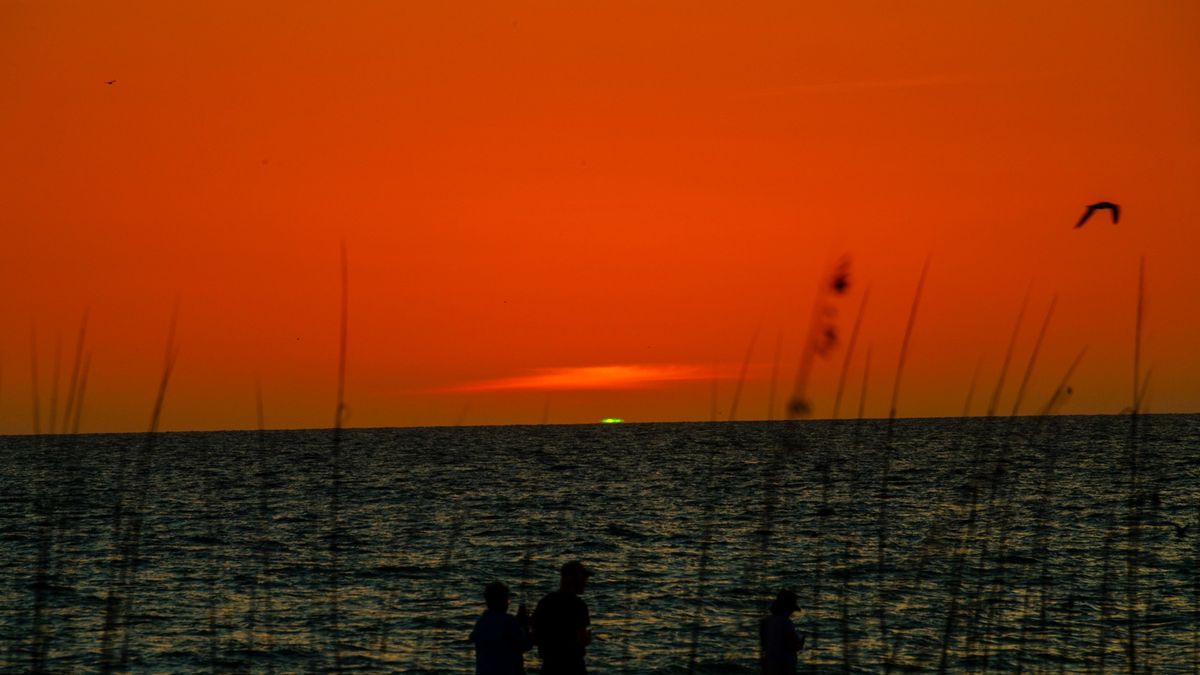Here’s something you might remember from your high school Earth science class: As sunlight—which appears to be pure white—passes through a glass prism, it is refracted, or bent. Different wavelengths of light bend by different amounts. In this way a prism can scatter a beam of white light into the rainbow spectrum.
Refractive color scattering can be seen in poor quality binoculars and telescopes. On such inexpensive instruments, the optics tend not to align properly, so sometimes you’ll see the full moon appear with an orange-yellow tinge to one side and a bluish tinge to the other.
However, remember again that the Sun and the Moon also – because it reflects direct sunlight back towards the Earth – are actually made up of a “heap” of different colored images. You can probably remember the fictitious name “Roy G. Biv,” with each letter representing a color in the spectral lineup: red, orange, yellow, green, blue, indigo, and violet.
Of course, we usually look at this group of colors at the same time, so that it appears more or less white.
Related: Planet Earth: everything you need to know
The atmosphere can act like a lens
Now when the Sun is located near the eastern or western horizon, the Earth’s atmosphere behaves in a similar way to poor quality optics, by separating the stack of images of different colors. Green and especially blue images are composed of short wavelengths and are scattered through the air. The red and orange images are composed of longer wavelengths that are more penetrating and as a result, they produce the red and orange colors seen at sunrise and sunset.
But there are very special cases, when the sky is so clear and exceptionally transparent, that a very small part of the green image can be seen just as the upper part of the sun rises or sets. This rare phenomenon is known as the “green flash”. The green color is produced by the refraction of light in the atmosphere, which causes near-horizon objects to appear slightly higher in the sky than they really are. Refraction is stronger for blue and green light than for yellow and red light, so the blue light of the sun is lifted somewhat more than the red light. This weak prismatic effect of the atmosphere results in a bluish or greenish fringe on the Sun’s upper edge—much like the effect of seeing the Moon through poorly aligned optical instruments.
Contemporary scenes
Surprisingly, the first mentions of a green flash are relatively recent – only at about 160 years old. This seems a little strange, since one might think that the diligent sky-watchers of ancient China, Japan and Babylon noticed this phenomenon.
The oldest undisputed scientific record of a green flash was created by W. Swan in 1865 when he saw a flash of “dazzling emerald green” at sunrise over a distant mountain. Interestingly, however, Swan didn’t publish his observation until 1883—the same year that people around the world reported sightings of green suns and other strange phenomena that occurred in the aftermath of the massive eruption of Krakatoa.
Some believe that Jules Verne’s 1882 novel, Le Rayon Ver (“Green Ray”) General attention was drawn to the phenomenon, and the great British mathematician, physicist and engineer William Thomson (known in his later years as Lord Kelvin) referred to Verne’s account when writing of the 1899 vision of the rarest “blue A flash” he watched as the sun rose over Mont Blanc, Switzerland.
elusive phenomenon
To underline how difficult the green flash can be, I would like to point out that I have been an avid sky-watcher for over half a century and have looked for the green flash on many different occasions, but I have witnessed it conclusively only twice.
The first occasion was on the morning of May 14, 1977 and was reported in the August 1977 issue of Sky and telescope Journal pages 150-151). Three other stargazers and I drove nearly 30 miles (50 km) east of Manhattan to Caumsett State Park, a Long Island bird sanctuary, to witness not one but two planets (Venus and Mars) hovering within 2 degrees of the waning crescent. Just before sunrise it was clear that the sky was exceptionally transparent and we all had a good feeling we had a good chance of catching a glimpse of the flash. I happened to be looking through the Celestron 8 telescope at just the magical moment when the upper edge of the Sun suddenly appeared dramatically on the nearby Connecticut coast as a beautiful emerald green color that lasted nearly two seconds.
The other occasion came many years later, in June 2019 on a cruise ship sailing to Bermuda. As my wife and I watched the sun descend toward the horizon, I noticed that the sky’s clarity looked good although I didn’t think it was clear enough to detect the green flash. Slowly, the sun’s disk sank below the horizon and just as the top of the sun was about to disappear, to our great surprise, we were treated to a very brief, bright green point of light on the horizon.
Viewing tips
That is the fancy green flash vision. His vision seems to be the exception rather than the rule. Sometimes they can appear in unfavorable circumstances while at other times, conditions may seem favorable to see them and yet they do not appear.
Here are a few things you should look for in hopes of seeing a green flash:
- The general conditions required are a distant, narrowly defined and low (preferably sea) horizon.
- To see a possible sunset, avoid looking at the sun until the last minute. there is a possibility of eye damage; Furthermore, a bright red image of the sun, after sunset, can leave a green afterimage in the eye that may be mistaken for a green flash.
- The cool weather, the absence of fog, and the red tints seem to favor the view.
- For a possible view of the sunrise, that point along the horizon where the sun rises may be, a few minutes before sunrise, fringed with a bright white or yellowish glow. Some call this the “fire effect,” and it sometimes seems auspicious to see a flash of green. Before catching the flash in 1977, I’d seen “flames” glow along the far horizon. This was my first introduction to the green flash.
I wish you all the best, and I hope you’re having the same fun!
Joe Rao is a teacher and guest lecturer in New York Hayden Planetarium. He writes about astronomy for Natural History Journalthe Farmers’ almanac and other publications.

“Extreme travel lover. Bacon fanatic. Troublemaker. Introvert. Passionate music fanatic.”




![The orbiting solar module captures the Sun's delicate corona in stunning detail [Video]](https://scitechdaily.com/images/ESA-Solar-Orbiter-scaled.jpg)


More Stories
Kim Kardashian was booed at Netflix's Tom Brady Roast
The orbiting solar module captures the Sun's delicate corona in stunning detail [Video]
Nicolas Cage's son is accused of beating his mother, Christina Fulton